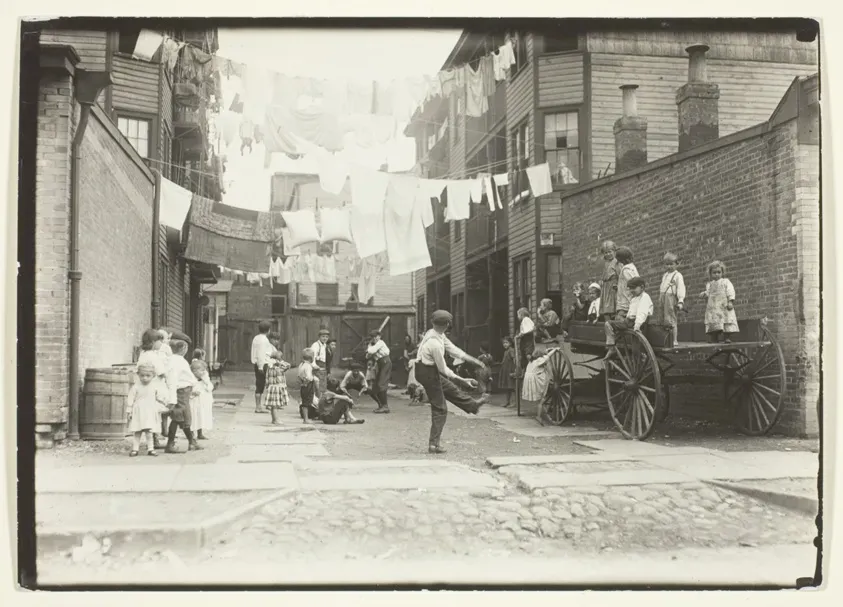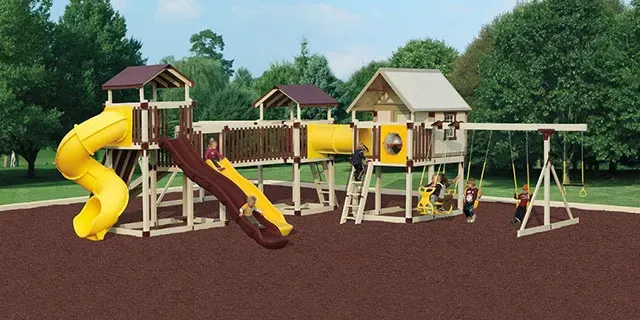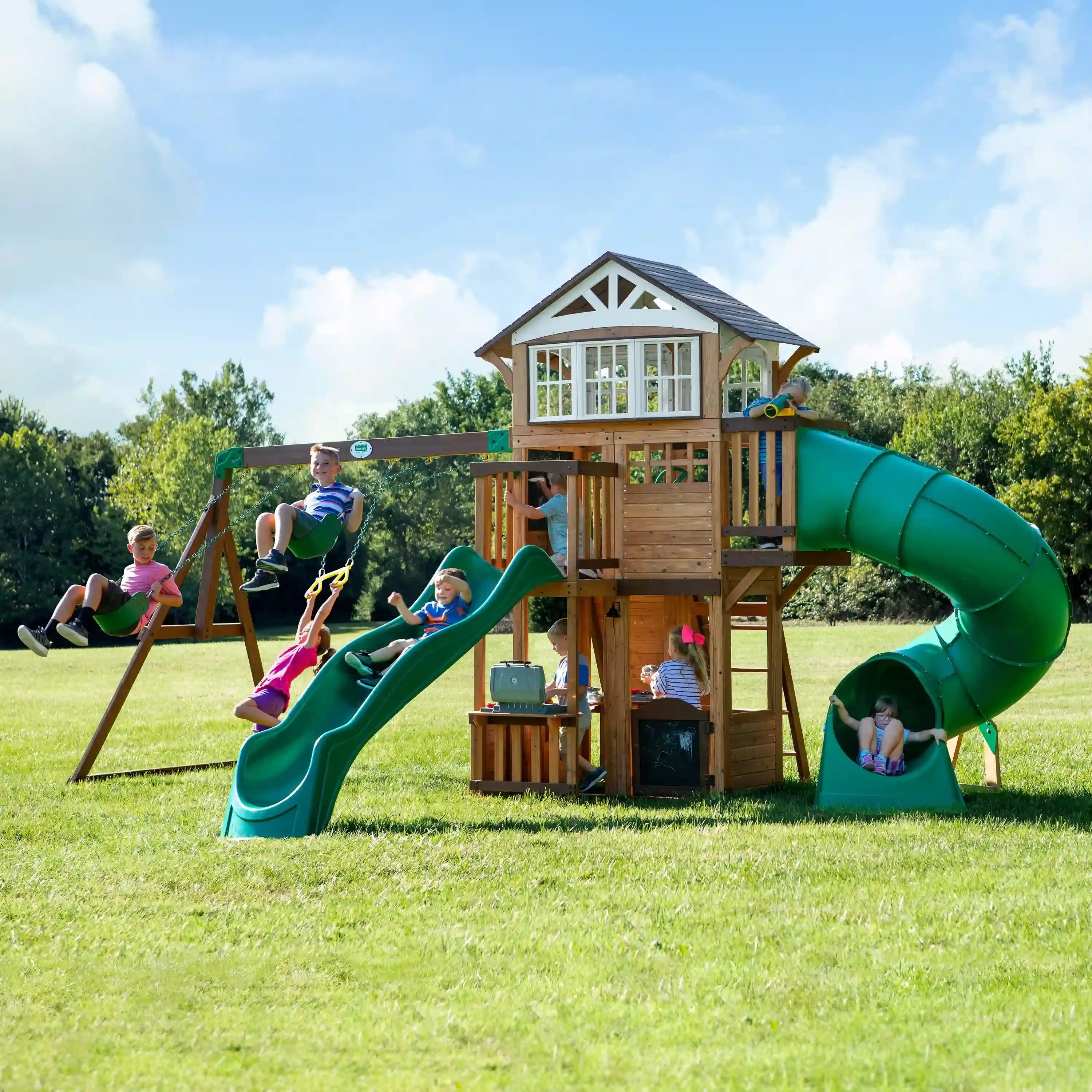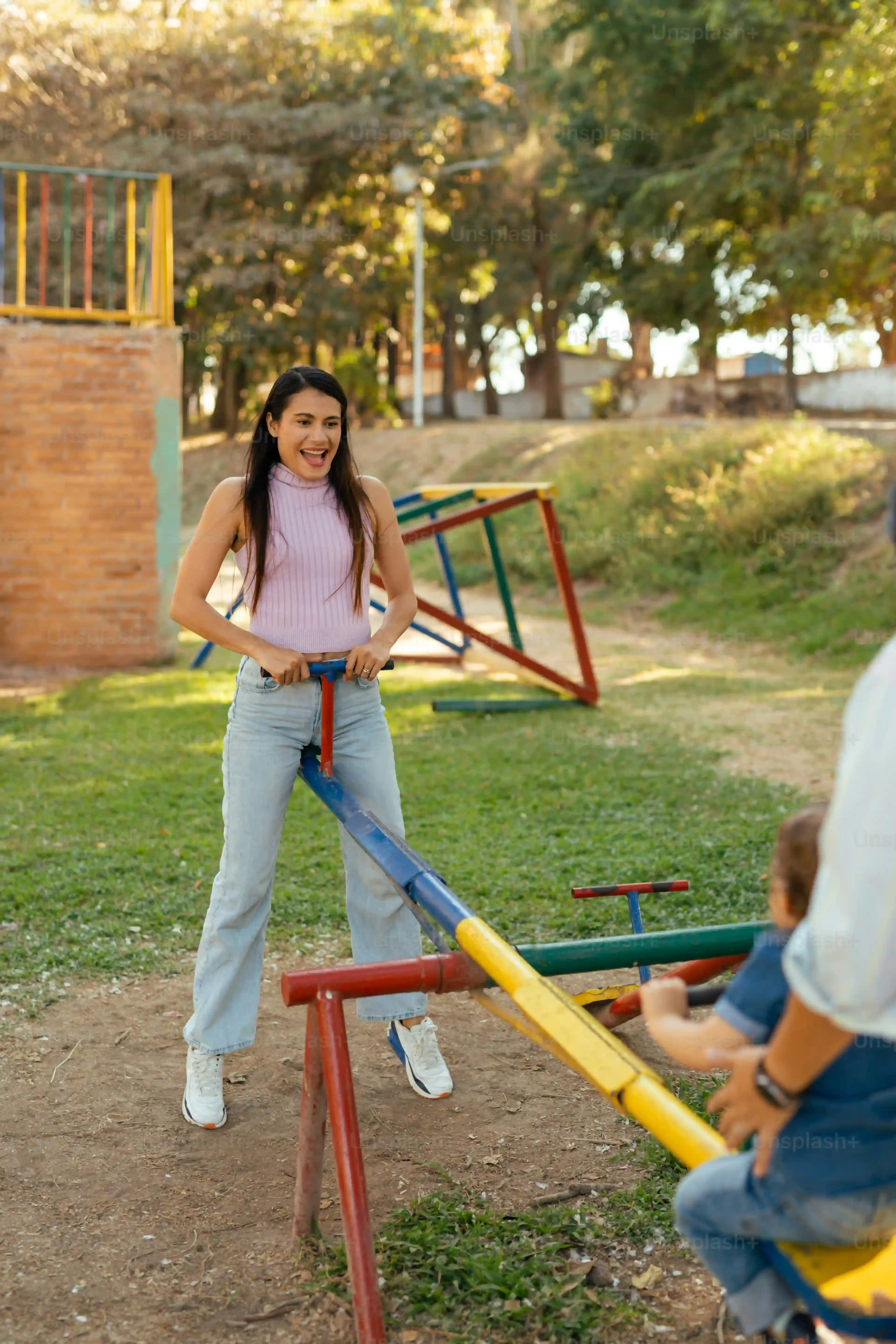Table of Contents
Remember when getting kids to play outside was easy? They just... went. Now, with screens everywhere, coaxing them off the couch can feel like negotiating a hostage crisis. You want them burning energy, breathing fresh air, maybe even developing some coordination that doesn't involve a game controller. That's where investing in quality residential outdoor playground equipment comes into the picture. It's not just a fancy backyard decoration; it's a strategic move to foster active lifestyles right outside your door.
Why Residential Outdoor Playground Equipment is More Than Just Fun

Why Residential Outdoor Playground Equipment is More Than Just Fun
Building Bodies and Brains, Not Just Boredom
Look, we all know kids need to move. But residential outdoor playground equipment does way more than just tire them out (though let's be honest, that's a huge perk). It's a fundamental building block for physical development. Climbing builds upper body strength and coordination. Swinging works their core and sense of balance. Sliding isn't just a thrill; it helps with spatial awareness. Think of it as a functional fitness center disguised as fun. They're not just playing; they're training for life, learning to navigate space, manage risks (small ones!), and push their physical limits safely. And let's not forget the sheer creative juice it sparks. A playset isn't just wood and plastic; it's a pirate ship, a castle, a space station. Their imagination takes over, turning simple structures into elaborate worlds.
Developing Skills That Stick (Unlike That Sticky Popsicle)
Beyond the physical, this stuff is a masterclass in social and cognitive skills. When kids play together on a swing set or a climbing frame, they have to negotiate. "It's my turn!" becomes "How about we take turns?" They learn sharing, cooperation, and conflict resolution (usually involving who gets to go down the slide next). They face challenges – maybe they can't reach the monkey bars yet. That frustration teaches perseverance. They figure out different routes, problem-solve how to get across, and gain confidence with every successful attempt. It’s real-world learning, the kind you can't get from tapping a screen. This is where resilience is forged, where they learn to try, fail, and try again, all while getting some much-needed Vitamin D.
Here are a few non-obvious benefits:
- Improved proprioception (knowing where your body is in space)
- Enhanced risk assessment (learning limits safely)
- Increased attention span (seriously, unstructured play helps)
- Better sleep patterns (tired bodies sleep better)
- Boosted immune system (fresh air and dirt are good!)
Finding Quality Residential Outdoor Playground Equipment That Lasts

Finding Quality Residential Outdoor Playground Equipment That Lasts
Materials Matter: What Your Playset is Really Made Of
you've decided the backyard needs an upgrade from just a patch of grass. Smart move. But before you click "add to cart," let's talk about what actually goes into decent residential outdoor playground equipment. You've got options: wood, metal, plastic, or some combination. Wood looks classic, but not all wood is created equal. You want something rot-resistant and splinter-proof, like cedar or redwood, or treated lumber specifically for outdoor use. Look for solid beams, not flimsy pieces that feel like they'll snap if a squirrel lands on them too hard. Metal, usually steel, can be super durable, but check for powder coating to prevent rust – nobody wants tetanus with their swings. Plastics should be thick, UV-resistant polyethylene that won't crack or fade in the sun like cheap patio furniture. The material is the foundation; get it wrong, and the whole thing is a short-term rental, not a long-term investment in backyard fun.
Construction and Hardware: The Devil's in the Details (and the Bolts)
Beyond the main stuff, poke around and look at how the residential outdoor playground equipment is put together. Are the joints reinforced? Are the bolts and screws heavy-duty and preferably recessed so kids don't scrape themselves? Flimsy hardware is a red flag for shortcuts taken during manufacturing. Check weight limits for swings, slides, and decks – they should accommodate multiple kids (and maybe an adult for a quick test swing when nobody's looking). A well-constructed playset feels solid, doesn't wobble excessively, and the pieces fit together snugly. Think about the ladder rungs and climbing holds – are they secure and sized appropriately for little hands and feet? Quality isn't just about the big pieces; it's about the hundreds of small details that keep it standing and safe year after year.
- Look for rust-resistant hardware (galvanized or coated).
- Check for reinforced joints and sturdy corner brackets.
- Ensure all nuts and bolts are capped or recessed.
- Verify weight ratings for all components meet your needs.
- Ask about the testing standards the equipment meets (like ASTM F1148 for home playgrounds).
Beyond Playsets: Adding Fitness to Your Residential Outdoor Playground Equipment

Beyond Playsets: Adding Fitness to Your Residential Outdoor Playground Equipment
Making Your Backyard a Full-Body Experience
Alright, let's talk about graduating from just swings and slides. While that's fantastic for the little ones, your backyard doesn't have to stop there. Why not make it a space that challenges the whole family, including the teenagers who think they're too cool for the slide and, yes, even you? We're talking about integrating fitness elements into your residential outdoor playground equipment setup. Imagine a pull-up bar next to the monkey bars, or parallel bars near the sandbox. It's about creating a multi-generational activity zone. No more standing around scrolling on your phone while the kids play; now you can get a quick workout in yourself. It shifts the backyard from just a kid zone to a functional, active hub for everyone.
Adding Muscle to the Mix: Equipment Options
So, what kind of fitness gear are we talking about? Think calisthenics. These are bodyweight exercises that build serious strength and control. You can add a robust pull-up bar station, maybe with different grip options. Parallel bars are excellent for dips and L-sits. A sturdy balance beam, perhaps integrated into a low obstacle course, improves core strength and coordination for kids and adults alike. Stepping stones or low hurdles can be fun for agility drills. Some companies even offer dedicated outdoor fitness stations that look like mini-gyms but are designed for the elements. The key is choosing pieces that complement your existing residential outdoor playground equipment and fit your available space, creating a flow between play and workout areas.
- Pull-up/Dip Stations: Classic strength builders.
- Parallel Bars: Great for dips, L-sits, and handstands.
- Balance Beams: Improves core strength and coordination.
- Agility Equipment: Cones, hurdles, or stepping stones for speed and footwork.
- Climbing Ropes/Walls: Builds grip strength and full-body power.
The Payoff: Active Family Time, No Excuses
Integrating fitness into your residential outdoor playground equipment isn't just about providing more things to do; it's about fostering a culture of activity at home. When kids see you using the pull-up bar, they're more likely to try it themselves. It normalizes exercise as part of daily life, not a chore. You get shared experiences – maybe teaching your kid how to do a proper pull-up, or having them cheer you on during a set of dips. It's hard to make excuses about not having time to work out when the equipment is twenty feet from your back door. Plus, it adds value to your property and makes your backyard genuinely unique. It's an investment in health, family connection, and frankly, a more interesting place to hang out than just another patch of grass.
Safety First: Understanding Standards for Residential Outdoor Playground Equipment

Safety First: Understanding Standards for Residential Outdoor Playground Equipment
Don't Skip the Small Print: Why Safety Standards Matter
so you've found some killer residential outdoor playground equipment that looks amazing and promises years of fun. Fantastic. Now, let's pump the brakes for a second and talk about the stuff that isn't quite as exciting but is absolutely non-negotiable: safety standards. This isn't bureaucratic red tape; it's the stuff that prevents broken bones, concussions, and trips to the emergency room. In the US, the main players are the ASTM (American Society for Testing and Materials), specifically standard F1148 for home playgrounds, and the CPSC (Consumer Product Safety Commission) guidelines. IPEMA (International Play Equipment Manufacturers Association) certification is another good indicator, meaning the equipment has been tested by a third party. Ignoring these standards is like buying a car without seatbelts because the paint job is nice. You need to know the manufacturer designed and tested their equipment to withstand intended use and, more importantly, anticipated misuse by fearless children.
Making Your Dream Backyard a Reality: Installation and Maintenance for Residential Outdoor Playground Equipment

Making Your Dream Backyard a Reality: Installation and Maintenance for Residential Outdoor Playground Equipment
Putting the Pieces Together: DIY or Call the Pros?
Alright, the boxes of your shiny new residential outdoor playground equipment have arrived. They're probably bigger and heavier than you imagined. Now comes the moment of truth: are you channeling your inner Bob Vila, or are you speed-dialing a professional installer? Let's be real, these aren't IKEA instructions translated by a drunk squirrel. They can be complex, involve heavy lifting, and require precision. A crooked support beam isn't just an eyesore; it's a safety hazard waiting to happen. If you're handy, have the right tools, and a patient helper (or two), DIY can save money. But if the thought of deciphering exploded diagrams makes your eye twitch, or if you value your weekends and your back, paying for professional installation is often money well spent. They've done it before, they have the specialized tools, and they can usually get it done faster and, crucially, correctly. My neighbor tried to assemble his swing set solo and ended up with a structure that leaned like the Tower of Pisa after three days. He eventually hired someone to fix it, costing him more in the long run.
Keeping it Shipshape: Regular Checks Are Key
Once your residential outdoor playground equipment is standing tall, the job isn't over. Think of it like owning a car; it needs regular check-ups. Sun, rain, snow, and enthusiastic children all take a toll. You need to make checking bolts, screws, and connections a routine. Are they tight? Is anything wobbly? Look for splintering wood, especially on decks, ladders, and swing seats. Metal parts can rust; plastic can fade and become brittle. Check ropes and chains for wear and tear. The ground surface beneath and around the playset is also critical – is the mulch or sand still deep enough to cushion falls? A quick monthly once-over and a more thorough seasonal inspection can catch small issues before they become big, expensive, or dangerous problems. It’s boring, sure, but way less boring than explaining to an ER doctor how little Timmy broke his arm on a loose swing hanger.
- Check all bolts, nuts, and screws for tightness.
- Inspect wood for splinters, cracks, or rot.
- Look for rust on metal parts and cracks on plastic components.
- Verify swing hangers, ropes, and chains are secure and not frayed.
- Ensure protective surfacing (mulch, sand, rubber) is at the recommended depth.
- Check for hazards like exposed concrete footings or sharp edges.
Battling the Elements and Time: Maintenance Hacks
Even with the best quality residential outdoor playground equipment, Mother Nature and rambunctious play will eventually cause wear. Wood may need sealing or staining every couple of years to protect it from moisture and UV rays. Rust spots on metal should be sanded and repainted promptly. Cracked plastic seats or worn swing ropes need replacing immediately – don't patch them up and hope for the best. Keep the area under and around the playset clear of debris, rocks, and roots. If you live in a snowy climate, consider covering certain components or even dismantling swings for the winter to prolong their life. Proper maintenance isn't just about aesthetics; it's about preserving the structural integrity and safety of the equipment for years of use. Think of it as proactive defense against decay and disaster. A little effort now saves a lot of headaches (and potential hospital bills) later.
Making the Investment Count
So, we've navigated the jungle of residential outdoor playground equipment, from understanding its importance in a screen-dominated world to deciphering safety standards and planning for the reality of installation. It's clear this isn't a purchase to take lightly. Choosing wisely means selecting gear built to withstand weather and enthusiastic use, ensuring it meets rigorous safety marks, and maybe even throwing in some fitness elements for good measure. A well-chosen setup transforms your backyard from just grass and maybe a sad-looking patio chair into a dynamic space that encourages movement and imaginative play. It requires thought, certainly, but the payoff – kids who actually want to be outside – seems a decent return on investment.